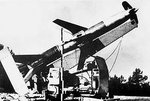P
PipsPriller
Guest
The Luftwaffe in all it's potent glory couldn't stop, nor even limit, the bombing effect of B-17's and B-24's.
So why do the Luftwaffe hopefulls think that it would do even as well against a bomber travelling 80mph faster than the older models, operating far above their operational ceilings and with a superior fire control system?
So why do the Luftwaffe hopefulls think that it would do even as well against a bomber travelling 80mph faster than the older models, operating far above their operational ceilings and with a superior fire control system?


